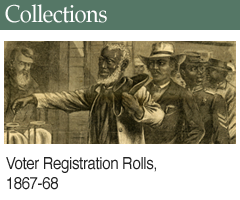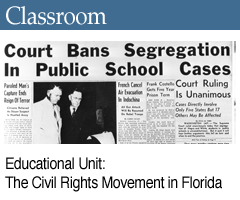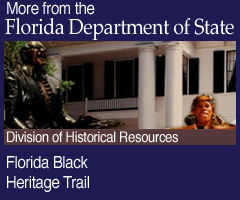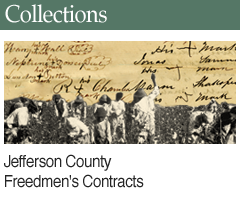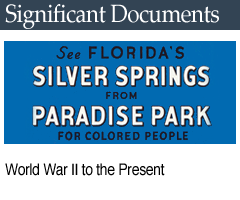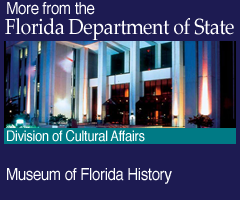Guide to African American Resources in the State Library and Archives of Florida
State Government Records: Executive Branch
The executive branch of Florida’s government consists of the governor, the Florida Cabinet and state agencies and departments under the authority of the governor. This section of the guide also lists relevant series from a variety of other state agencies, departments and entities. The records are identified by record group (RG) and then by series number (S___) and are described by series creator, title, dates, quantity, general scope and relevant content.
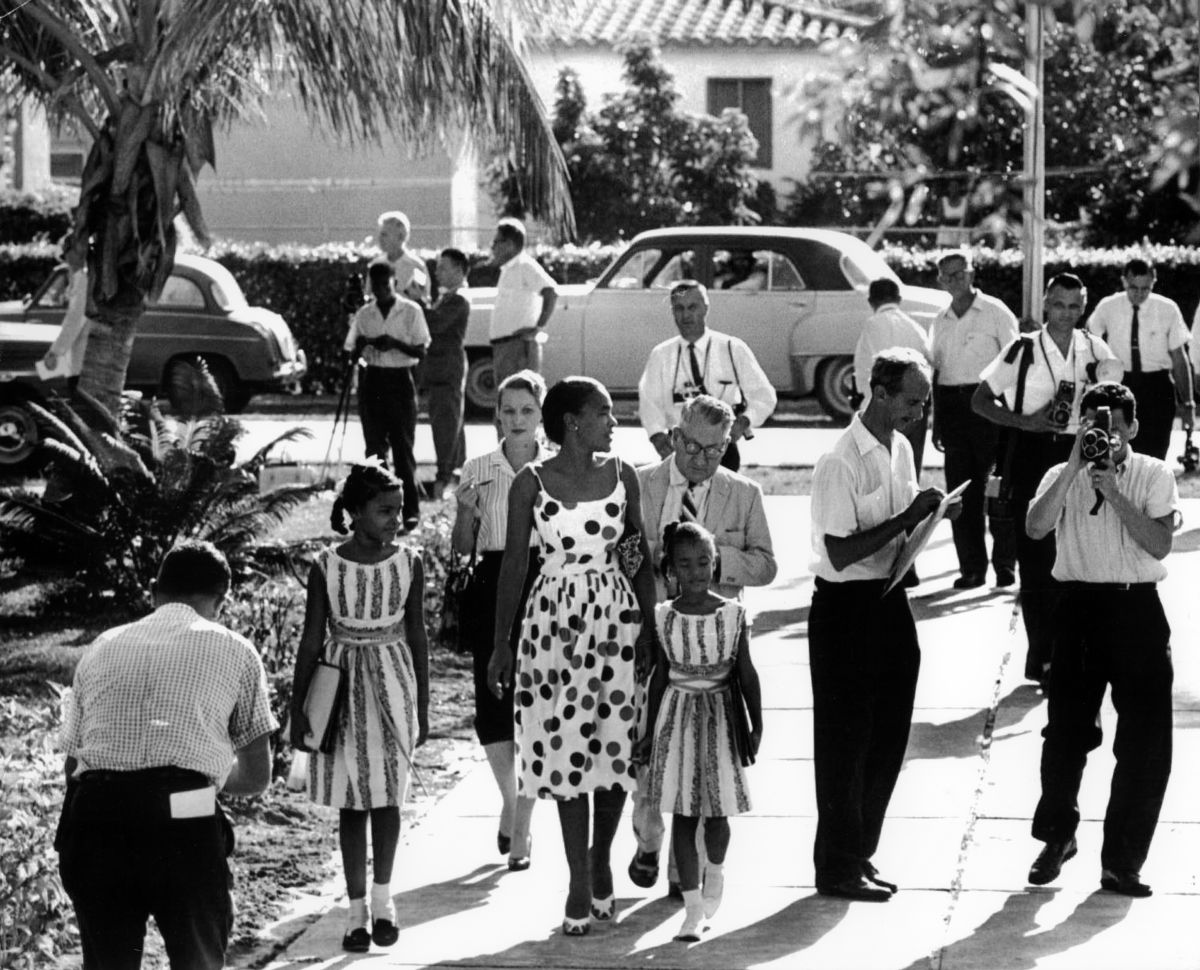
Mother escorts her two daughters to Orchard Villa School. (State Archives of Florida / PR05173)
RG 100 Office of the Governor
S79
Florida Governor's Commission on the Status of Women
Records, 1974-1985
18 cubic feet
The Governor’s Commission on the Status of Women was established in 1964 and activated in 1972. The Commission was involved with such projects as ratification of the Equal Rights Amendment, Talent Bank (source referral for employment or appointment of women to high-level positions) and the establishment of local commissions to aid women throughout the state. This series includes files pertaining to such subjects as minority business development, urban leagues, civil rights and the League of Women Voters, the membership of which includes Black women.
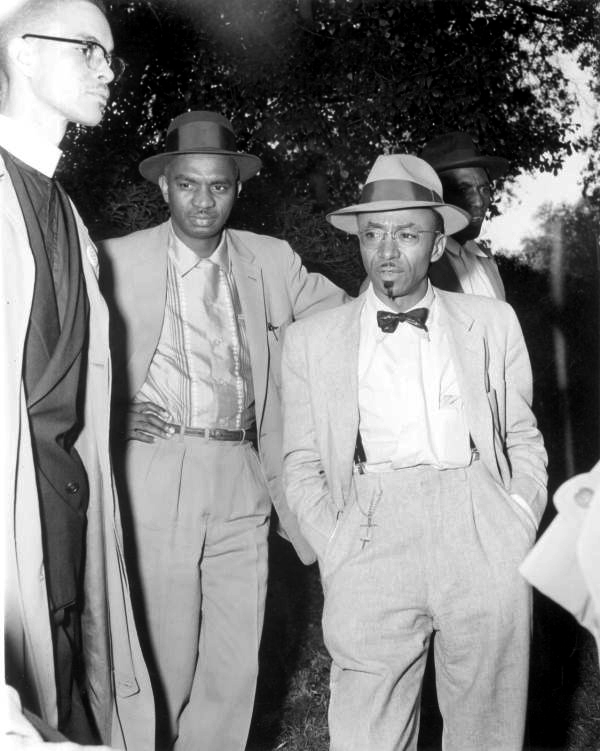
Reverend C. K. Steele (right) and Edwin Norwood (middle) protested segregated seating on Tallahassee city buses in December 1956, almost seven months after the boycott began.(State Archives of Florida / RC12421)
S168
Governor’s Conference on Education, Tampa, Fla.
Records, 1965-1966
4 cubic feet
The Governor's Conference on Education, created by Governor Haydon Burns, was held February 24-25, 1966 "to provide for thorough-going discussion of Florida's educational program." The conference covered numerous issues and recommendations for Florida’s education system and included discussion of the implementation of the Civil Rights Act and school integration.
S226
Florida Governor's Advisory Commission on Race Relations Records, 1957-1961
7.25 cubic feet
The Florida Legislature created the Florida Governor's Advisory Commission on Race Relations in 1957. Popularly known as the Fowler Commission after Chairman Cody Fowler, the commission was intended to study race relations in the state and to help anticipate disturbances of the peace and suppress violence. The series documents school desegregation policies, racial disturbances and civil rights activities and includes a copy of the commission's final report, which centers on school desegregation. There are speeches regarding race relations and commission correspondence with the Commission on Civil Rights, National Urban League, Fair Employment Practices Commission, Urban Renewal Administration, Black Supremacy Cult, the United Nations, the Southern Regional Council and others. Other correspondence documents race relations in Jacksonville, Miami, Tallahassee and other cities around the country.
S2399
Martin Lee Anderson Litigation Case Files, 2003-2006
1.5 cubic feet
Martin Lee Anderson was a 14-year-old Black teenager who died while incarcerated at the Bay County Sheriff's Office Boot Camp in Panama City. Anderson collapsed during a 1.5-mile run at the camp, and security footage later released showed the guards physically abusing Anderson when he fell. This series contains legal records documenting the role of the Governor’s Office of General Counsel in litigation with the Department of Juvenile Justice during the death investigation of Anderson. The investigation included a review of policies and practices of the Bay County Sheriff's Office, the Department of Juvenile Justice and the District Fourteen Medical Examiner's Office. Records include correspondence, investigative research and reports, pleadings, trial briefs and various other court documents related to the case.
RG 101 Territorial and State Governors, 1820-1929
S177
Territorial Governors
Correspondence, 1820-1845
1.75 cubic feet
This series contains the extant incoming correspondence of territorial Governors William Pope Duval (1822-1834), John Henry Eaton (1834-1835), Richard Keith Call (1835-1840; 1841-1844), Robert Raymond Reid (1840-1841) and John Branch (1844-1845).
The records include reports, correspondence and receipts regarding enslaved Blacks and free Blacks from 1830-1831. Topics include, but are not limited to, sentencings of slaves convicted of crimes; requests for militia deployments in regard to potential/impending slave revolts; purchases of material supplies by free African Americans on record by shopkeepers; and letters by free Blacks to territorial Governor Duval regarding personal or developing matters.
S664
Governor Broward
Correspondence, 1905-1908
8 cubic feet
This series consists of official correspondence of Napoleon Broward, Florida’s 19th governor. Broward is credited with consolidating the state-subsidized higher education institutions into three colleges, including what was then called the Colored Normal School and later became Florida Agricultural and Mechanical College.
The file contains two booklets and correspondence regarding each: “New Plans for the Uplift of a Race” concerns matters of religious and literacy education of Blacks while “The Race Question” argues for Jim Crow era segregation laws against Blacks. The letters recommend that the booklets be read and considered with future policymaking.
S755
Thomas Brown
Correspondence, 1849-1853
1.25 cubic feet
Thomas Brown was Florida's second governor, serving from 1849 to 1853. The series consists of appointments, pardons, correspondence and other related records including information on slavery, military affairs and government relations with Native Americans.
S777
James Emilius Broome Correspondence, 1853-1857
1.25 cubic feet
James Emilius Broome was governor from 1853-1857. The series contains records including information on slavery, military affairs and government relations with Native Americans.
RG 102 Governors, 1929-1971
S131
[William] Haydon Burns
Correspondence, 1965-1967
34 cubic feet
The term of William Haydon Burns, 35th governor, was shortened due to a change in election cycles. During his two-year term, Burns focused primarily on education, reapportionment and highways. He appointed the first Black member of the Board of Regents, Clifton Dyson. This series contains records on such subjects as civil rights, race relations and Florida A&M University.
S204
Doyle Elam Carlton
Correspondence, 1929-1933
46.25 cubic feet
Doyle Elam Carlton served as Florida's 25th governor during one of the most critical peacetime periods in Florida's history. The state faced severe financial problems because of the Great Depression and Florida's dismal economy. The series includes folders on Florida Agricultural and Mechanical College, the cotton industry, convict labor and lynching.
S235
Fuller Warren
Correspondence, 1949-1953
52.5 cubic feet
This series consists of the administrative correspondence of Fuller Warren, Florida’s 30th governor. During Warren’s administration, a Black student named Virgil Hawkins was denied admission to the University of Florida Law School due to his race, and several folders in this series relate to this denial and the Board of Control. This series also includes folders on Florida Agricultural and Mechanical College, labor and lynching.
S278
David Sholtz
Correspondence, 1933-1937
60.25 cubic feet
Correspondence of Florida’s 26th Governor David Sholtz reflects the effects of the Great Depression on Florida and the governor's determination to alleviate the state's economic crisis. Pertinent subjects concerning Black history include activities of the National Association of the Advancement of Colored People (NAACP) relating to racial violence in the state; Black enrollee camps of the Civilian Conservation Corps; Bethune-Cookman College; and Florida Agricultural and Mechanical College.
S368
Fredrick Preston Cone
Correspondence, 1937-1941
50.25 cubic feet
Correspondence of 27th Governor Fredrick Preston Cone documents subjects such as Florida Agricultural and Mechanical College, lynching and Ku Klux Klan activities in Dade and Hillsborough counties. The series also includes a photograph of Black schoolchildren in Dade County.
S406
Spessard Lindsay Holland
Correspondence, 1941-1945
60.5 cubic feet
Correspondence of 28th Governor Spessard Lindsey Holland includes topics involving the Florida Agricultural and Mechanical College, labor and race, as well as lynching.
S569
Daniel Thomas McCarty and Acting Governor Charley Eugene Johns Correspondence, 1953-1955
23.5 cubic feet
Governor Daniel Thomas McCarty served only from January to September 1953, dying from complications from two heart attacks he suffered while in office. Senate President Charley Johns then served as acting governor until the inauguration of LeRoy Collins. Official correspondence of Governors McCarty and Johns covers subjects such as civil rights and Florida Agricultural and Mechanical University.
S576
Millard Fillmore Caldwell
Correspondence, 1945-1949
41.75 cubic feet
Correspondence of 29th Governor Millard Fillmore Caldwell includes topics covering Civil Rights, Florida A&M, and lynching. Florida’s response to the itinerary of the American Freedom Train (as it traveled throughout the state) is found in this series as well – the traveling exhibit featuring the Emancipation Proclamation, though, included little else promoting Black history.
S756
[Cecil] Farris Bryant
Correspondence, 1961-1965
77.75 cubic feet
Cecil Farris Bryant was Florida's 34th governor and an advocate for segregation. In March 1964, demonstrations broke out in St. Augustine from a movement to desegregate motels and restaurants. The series topics directly related to this event: Attorney General - Segregation Cases, Civil Rights, Labor, Legislative Investigation Committee, Race Relations and the Barnett Commission, as well as St. Augustine and the Special Investigation of St. Johns County. Also includes various other documentation relating to legal matters and to St. Johns County from 1964.
S776
[Thomas] LeRoy Collins
Correspondence, 1955-1961
74.5 cubic feet
Governor LeRoy Collins entered office as a supporter of segregation but worked to protect and improve race relations and later modified his views. Collins expressed a complicated opinion on the subject in his remarks on the Legislature’s 1957 “interposition” resolution which was filed in response to the United States Supreme Court’s decision in Brown v. Board of Education ending school segregation. In a handwritten message addressed to future researchers, Collins declared that while he disagreed with the Court’s decision, he believed that noncompliance was not legally in the power of the states. He later became a more vocal supporter of desegregation.
Governor Collins’ administration created the Advisory Commission on Race Relations, and their activities are detailed across the series. There are also letters to the governor from such persons and organizations as Roy C. Wilkins, Executive Director of the NAACP; Reverend C.K. Steele, Tallahassee civil rights activist and member of the Southern Christian Leadership Council (SCLC); the Southern Regional Council; the Congress of Racial Equality (CORE); the National Baptist Convention; and the Commission on Race Relations. Documentation on the landmark Florida Supreme Court case Virgil Hawkins v. The Florida Board of Control is also included. There is also documentation of the “Leon County Incident” which contains letters demanding justice to prevail in the case of a mass rape of a Black student. The Special Investigation - Lake County records document the case of children denied admittance to a white school because they looked Black. Other files pertaining to Black history are those such as the Commission on Civil Rights, Board of Control, Walter Lee Irving, the Ku Klux Klan, Legislative Investigation Committee, Migrant labor, Florida A&M University, and various other topics involving Segregation.
S923
Claude Roy Kirk Jr.
Correspondence, 1967-1971
65 cubic feet
Claude Roy Kirk Jr., 36th governor of Florida, was Florida’s first elected Republican governor since 1872. In April 1970, when the United States Supreme Court ordered the busing of Manatee County schoolchildren, Kirk ordered the district to disregard the orders. He then suspended the orders twice in the ensuing battle that ended with Kirk relenting and allowing busing to begin. Other subjects covered include civil rights, minority education, race relations, ‘racial situations’ in both Jacksonville and Tampa Bay, school disturbances, the Palm Beach County Sheriff Department, Education School Crisis, and Florida Agricultural and Mechanical University.
S926
Claude Roy Kirk, Jr.
Legal Files, 1967-1971
9 cubic feet
This series consists of transcripts of hearings, reference notes, published reports, meeting agendas and minutes, investigative reports and correspondence documenting the legal activities of the Kirk administration in many areas, including school integration and forced busing.
RG 103 Governor Reubin O'Donovan Askew, 1971-1979
S126
Education Coordinator
Subject Files, 1968-1979
24 cubic feet
This series contains the subject files of Education Coordinators Dr. William Malloy, Dr. Claud Anderson, and Huette Higgs, and special assistant Dr. Marshall Harris. These records relate to major issues concerning education during Governor Askew’s term and include correspondence, reports, budgets and publications. Topics include Black attorneys, Historically Black colleges, the Civil Rights Board, the Civil Rights Commission, the Congressional Black Caucus, Desegregation, Integration, elderly minorities, the NAACP, as well as race relations in schools. Some of the records date from Governor Kirk’s administration.
S681
Special Assistant T.J. Rose
Subject Files, 1977-1978
2.5 cubic feet
T.J. Rose was Special Assistant to Governor Askew in the area of human relations. The files contain correspondence and reference materials regarding appointments of Black Floridians to positions in state government, Black organizations, the Department of Commerce, economic development, worker's compensation and the Florida Commission on Human Relations.
S966
Social Services Aid Guy Spearman
Subject Files, 1976-1978
8.50 cubic feet
Social Services Aid Guy Spearman acted as advisor to Governor Askew in matters relating to the Department of Offender Rehabilitation, corrections, prisons, crimes compensation and economic development. The records include correspondence, memoranda, reports and newspaper clippings. The series includes NAACP correspondence and records of the Harlem National Committee on Human Rights.
RG 104 Governor [Daniel] Robert Graham, 1979-1987
S850
Issue Correspondence, 1979-1984
35.75 cubic feet
The series contains incoming correspondence pertaining to major issues faced by the Graham administration, such as the 1980 Miami riots following the acquittal of Dade County public safety officers in the violent traffic stop death of Arthur McDuffie. The records originated in the governor's Legal and Legislative Affairs offices and the Commission on the Status of Women.
S889
Subject Files Relating to the Miami Riots, 1966-1969, 1980-1981 2 cubic feet
The series contains records regarding the Miami Riots of 1968 and 1980. The 1980 records include population studies of Miami, Dade County Citizens’ Committee minutes, investigation files, Federal records on civil rights in Florida and newspaper clippings. The 1969 records include reports and background materials, and newspaper clippings from before, during and after the riots.
S1458
Office of Minority Affairs Administrative Files, 1979-1986
6 cubic feet
The role of the Office of Minority Affairs was to ensure minority access to and participation in state government. The records, documenting affirmative action programs and assistance to minority and small enterprises, include correspondence, memoranda, subject files, reports and photographs.
RG 108 Governor John Ellis “Jeb” Bush, 1999-2007
S1985
Capital Cases Task Force Files, 2000
4.50 cubic feet
This series documents the activities of the Capital Cases Task Force (CCTF) in researching discrimination in the sentencing of defendants in capital cases. The series consists of articles, reports, recommendations, correspondence, expert witness testimony, case law, law reviews, unofficial transcripts of meetings, handwritten notes of unidentified task force members, statistical findings regarding demographics of death row inmates and the death penalty, a videotape by Temple University Institute on Disabilities, and cassette tape recordings of the CCTF meetings. The series documents topics such as the impact of race on sentencing in capital cases, racial characteristics and prosecutorial discretion.
S2094
Appointees Demographic Statistics, 1999-2005
0.308 megabytes (7 Files)
This series consists of demographic statistics for Governor Bush appointees, indicating number and percentage by race, gender and political party affiliation.
RG 119 Office of the Lieutenant Governor
S1487
Kenneth “Buddy” MacKay
Correspondence, 1990-1999
24.25 cubic feet
The series contains the correspondence of Lt. Governor MacKay covering a variety of governmental issues including abortion, children's issues, economic development, education, environment, housing, transportation and welfare reform, as well as oversight of Executive Branch agencies. The series also includes topics such as Affirmative Action, minority issues, and records related to various investigations of and legislative actions concerning the Rosewood Massacre that occurred in January of 1923. The records associated with Rosewood are mainly newspaper articles collected by the office from various local and national outlets in the 1980s and 1990s.
RG 145 Board of Commissioners of State Institutions
S42
Convict Lease Program Subject Files, 1890-1916
4.5 cubic feet
The series documents the state's administration of the convict leasing system. Under this system, while the state retained custody of them, prisoners could be leased as laborers to private businesses. Prisoners were commonly leased for labor in the railroad, cotton and turpentine industries. The bulk of the records are from 1913-1915. Included are reports and correspondence concerning convict camp conditions, investigations and prisoner data. Black men comprised as much as 90 percent of the population of Florida’s convict lease system by the 1890s.
RG 147 Division of Child Training Schools
S357
Case Files, 1963-1967
37 cubic feet
This series contains case files documenting the services provided to juvenile offenders. The case files include the child’s personal background and offense, and may contain correspondence, orders of commitment and applications for admission into a state institution. Children were admitted to the Florida School for Boys in Marianna and Okeechobee and the Florida School for Girls in Ocala and Forest Hills.
S436
Division of Child Training Schools
Subject Files, 1952-1967
13.75 cubic feet
Subject files of the Division of Child Training Schools include operating files, financial records and correspondence relating to operations of the various schools for juvenile offenders. These schools were initially segregated, and some records deal with integration.
RG 150 Department of State
S13
Proclamations and Executive Orders, 1845-1995
38 volumes, 4.50 cubic feet
This series consists of proclamations and executive orders issued by the governor announcing special events, special legislative sessions and special elections. The earlier volumes contain additional records, including articles of incorporation, election canvass returns, indentures, mortgage and deed statements, and extraditions. This series includes proclamations honoring and recognizing Black individuals and organizations.
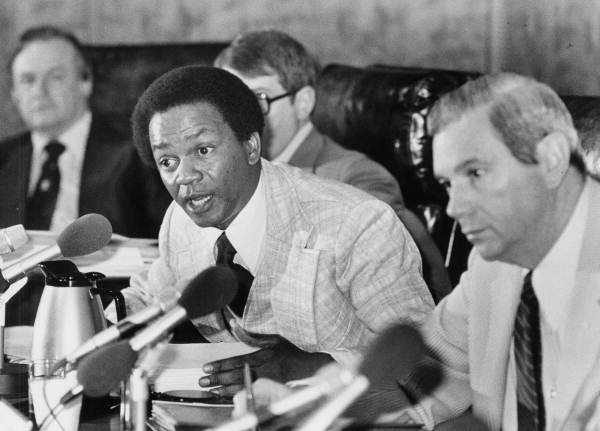
Jesse McCrary with Governor Reubin Askew and other cabinet members. (State Archives of Florida / RC12718)
S180
Secretary of State Correspondence, 1971-1980
34.5 cubic feet
The series consists of general correspondence, reports and memoranda documenting the work of the Department of State under Secretaries Richard Stone (1969-1974), Bruce Smathers (1975-1978), Jesse McCrary (1978-1979) and George Firestone (1979-1987). Jesse McCrary was Florida's second Black Secretary of State.
S501
Secretary of State Tom Adams
Subject Files, 1961-1970
39 cubic feet
Secretary of State Tom Adams’ subject files contain reports, letters, cabinet agendas and minutes from 1964 to 1966, campaign material, correspondence, memoranda, statements, bills and other legislative and political documentation. The files document the secretary's involvement in Cabinet matters, diplomacy and foreign trade, and the activities of the department's various divisions relating to elections, archives, records management and libraries. The series documents the Bi-Racial committee, the Civil Rights Act, Florida Agricultural and Mechanical University Hospital, Voting Rights Act, 1965-1970 and incidents regarding racial unrest.
S697
Secretary of State Tom Adams
Press Files, 1961-1970
12 cubic feet
This series consists of subject files containing speeches, addresses, press releases, newspaper clippings, correspondence, memoranda, reports, photographs, films and audio tapes. Files on civil rights, Black employment, race relations and student demonstrations contain materials of interest.
S2386
Florida Photographic Collection Development Files, 1952-2007, bulk 1980s-1990s
4 cubic feet
This series documents the early creation and operation of the Florida Photographic Collection and program. The records provide information related to the research and implementation of policies and procedures, collection development and maintenance, and outreach activities such as exhibits and digitization. The types of records include correspondence within the Department of State and with donors; indexes and guides for collecting areas; grant application materials; and monthly and annual reports. The files include records created to support photo exhibits produced on “Black History” in 1987 and “African Americans” in 1999.
RG 151 Office of the Secretary of State
S21
Election Returns by County, 1824-1926
26.50 cubic feet, 10 microfilm reels 35 mm
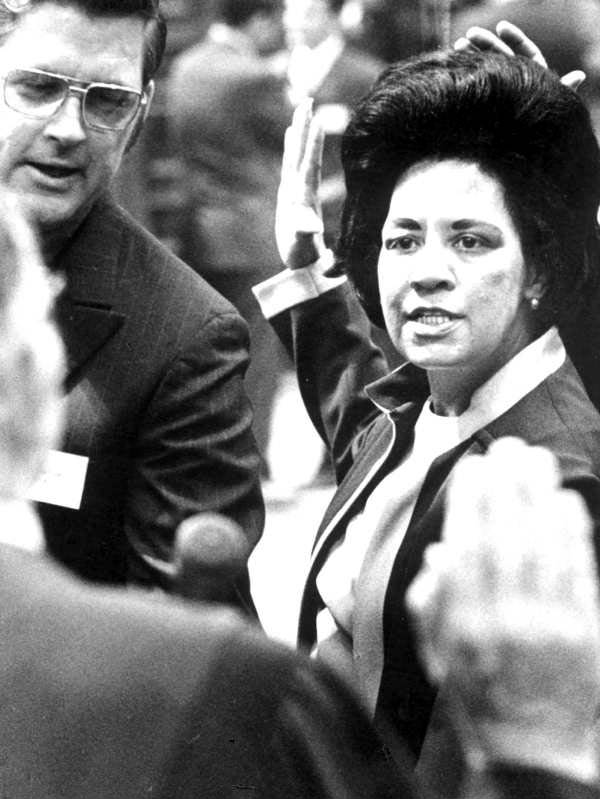
Representative Gwen Cherry sworn in as the first Black woman in the State Legislature.(State Archives of Florida / PT02668)
This series contains the returns of national, state, county and military elections. Included are some poll books, voter registration lists and sample ballots. The elections are for county offices (sheriffs, justice of the peace and tax collector), state offices (governor, state legislators), national offices (president, congressional representatives) and officers for local or home guard units during the Seminole wars, the Civil War and other wars. Also included are returns on referendum votes on laws.
The returns also document the vote counts for Black candidates elected to national, state and county offices. For example, Josiah T. Walls, Florida's first Black Congressman, was three times elected to the United States House of Representatives and twice unseated. In addition, he won election to the Florida House of Representatives in 1868 and to the Florida Senate in 1869. In 1968, Joe Lang Kershaw of Dade County became the first Black person elected to the Florida Legislature since 1889. Gwendolyn Sawyer Cherry became the first Black woman to serve in the Florida Legislature when she was elected from Dade County in 1970.
S24
Secretary of the Territory and Secretary of State
Letterbooks, 1830-1865, 1889-1905, 1922-1926 22 volumes
The series contains the outgoing correspondence of the Secretary of State and predecessor Secretary of the Territory documenting all aspects of the duties and responsibilities of the Secretary of State. Included in this series is the official correspondence of Jonathan C. Gibbs, Florida’s first Black Secretary of State from 1868 to 1873.
S98
Voter Registration Rolls, 1867-1868
7 cubic feet, 2 microfilm reels
The series contains the existing voter registration rolls for 1867 to 1868 and is particularly significant as this was the first time Black men were allowed to register to vote in Florida. Most volumes in this series list voter's name, race, time of residence in county and state, native (of what state), naturalization (when, where and how) and date of registration. For most Black Floridians listed in the records, this is the earliest instance of their inclusion by their full name on an official state document.
S222
Acts of the Territorial Legislature and Acts of the Legislature, 1822-2015
1,130 volumes, 62 cubic feet
This series contains the original acts, resolutions and memorials of the Territorial Legislature from 1822 to 1844 and the State Legislature since 1845. The acts from 1822 to 1918 are all handwritten and are often contained in oversized boxes and volumes. Acts from 1919 to the present are typed and bound in numbered volumes. Many of these acts legally conferred or denied rights to the people of Florida, often based on race and/or sex, and some legislated the treatment of enslaved and/or freed Black persons.
S1284
State and County Directories, 1845-1997
65 volumes
This series serves both as a listing of state and county officials and as an index to other volumes containing records of commission issued to individuals who were appointed or elected to state or local government offices. The commissions can be found in Record of Commissions, 1845-1900 (S1285), Record of Commissions for State Appointive Officers, 1898-1964, 1969-1978 (S1286), Record of Commissions for County Appointive Officers, 1901-1951 (S1287), Records of Commissions for County Elective Officers, 1898-1963, 1969-1978, 1989-2004 (S1288), Record of Commissions for Ad Interim Elective Officers, 1906-1935 (S1289) and Record of Commissions for Senate Confirmed Officers, 1913-1963 (S1290). Gaps in the series occur for the years 1858 to 1861 and 1864 to 1870.
S2000
United States Presidential Election 2000 Vote Count Deadline Extension Correspondence, 2000-2001
14.25 cubic feet
This series contains letters, faxes, printed email transmissions and phone message logs related to the controversial 2000 Presidential Election. The correspondence includes complaints from Florida voters, often expressing support or opposition to the Secretary of State and her decision not to extend the deadline for ballot certification, the process of hand counting contested ballots, or the request for a re-vote in Florida. One folder within the series contains correspondence voicing concerns over racial discrimination in the form of voter disenfranchisement.
S2153
Territorial and Early Statehood Records, 1821-1878
6 cubic feet
This series contains correspondence, petitions, legislative acts, resolutions and committee reports of the Secretaries of State, the territorial and state governors, the general assembly, citizens of Florida and officials of other states. The series consists of nine topic-based subseries. Some records within Subseries 4 deal with abolition, while Subseries 8 consists of 96 items relating to the rights of Black persons between 1824 and 1878, including correspondence, petitions, memorials and copies of bills.
S2321
List of Registered Electors in Leon County, 1874-1876
1 cubic foot
This series consists of several copies of a list of registered electors or voters in Leon County for the General Election in 1874. The Office of the Secretary of State may have produced these lists to distribute among the county's precincts; some are inscribed with community names and numbers including Tuscawilla No. 7, Tallahassee No. 2, Belair No. 6, and Lake Hall No. 8. Used in conjunction with census records, this series would be an invaluable source of information regarding county residents in the Reconstruction era.
RG 154 Division of Archives, History, and Records Management
S538
Black Archives Conference Proceedings, June 1974
2 audio cassette tapes
The Division of Archives, History, and Records Management and Florida International University cosponsored a conference on archives called by Secretary of State Dick Stone to assure Floridians of all backgrounds, beliefs and interests that records of their lives and achievements would be collected, preserved and made available for future generations. This series consists of two cassette recordings of the Black Archives Conference. Featured speakers included Secretary of State Dick Stone; Bobbi Hardwick, Florida International University; Dr. Harold Pinkett, National Archives; Nicholas E. Gaymon, Florida Agricultural and Mechanical University; Leroy Thompson, Florida Memorial College; and State Representative Gwendolyn Cherry. No transcripts are available.
RG 155 Division of Historical Resources
S2300
Florida Historical Commission Meeting and Grant Files, 1971-2007
28 cubic feet
This series documents the development and implementation of historic preservation activities of the Historic Preservation Commission (2002-2007) and its predecessor agencies the Bureau of Historic Sites and Properties Advisory Council (1971-1979) and the Historic Preservation Advisory Council (1983-2001). The series includes agendas, correspondence, minutes, press releases, newspaper clippings, grant rankings and funding recommendations, project proposals, and state and federal grant applications and background materials. The series includes two cubic feet of records detailing the activities of the Study Commission on African-American History in Florida and the Florida Black Heritage Trail and Guidebook.
RG 156 Division of Elections
S12
Death Warrants, 1869-1972, 1992-2012
23.25 cubic feet, 3 volumes
Death warrant files for executions carried out in Florida include correspondence relating to the warrants and executions, transcripts of court testimony, and reports and correspondence to the Clemency Board. In addition, three volumes (1869-1965) contain copies of all the death warrants issued.
S622
Oaths and Bonds, 1845-2014
78.50 cubic feet
The series documents the oaths, bonds, appointments and resignations of state and county government officials in Florida, including some of Florida’s first Black public officials. The files contain each official’s name, county, date, office, amount of bond and oath.
S708
County Voter Registration Files, 1920, 1952-1972
1 cubic foot
This series documents county voter registration in Florida and includes registration figures for general and primary elections, presidential preferential primaries, special elections and 18-year-old registration statistics. The figures are broken down by party affiliation and racial demographic. The 1920 records are the county registration figures for the primary election.
S1258
Election Return Canvasses, 1865-2004
219 volumes
This series contains national, state and county election canvasses for Florida. The canvasses, conducted to determine the validity of elections, were official examinations of votes and confirmed votes received by each candidate. State and county canvassing boards conducted the canvasses.
S2677
Director’s Office Correspondence and Memoranda, 1980-2009, bulk 2001-2008
26 cubic feet
This series contains records that document the administrative duties of the Office of the Director within the Division of Elections. The records provide information about federal and state voting legislation, voter issues, election publicity and outreach programs, electronic voting, election fraud, recounts and various other related topics. The series includes correspondence with the public regarding these topics as well as routine interactions such as voter assistance and registration, candidacy status and voter support or disagreement. Also included are records relating to the Voting Rights Act of 1991 and litigation filed by the NAACP.
RG 158 Florida Folklife Program
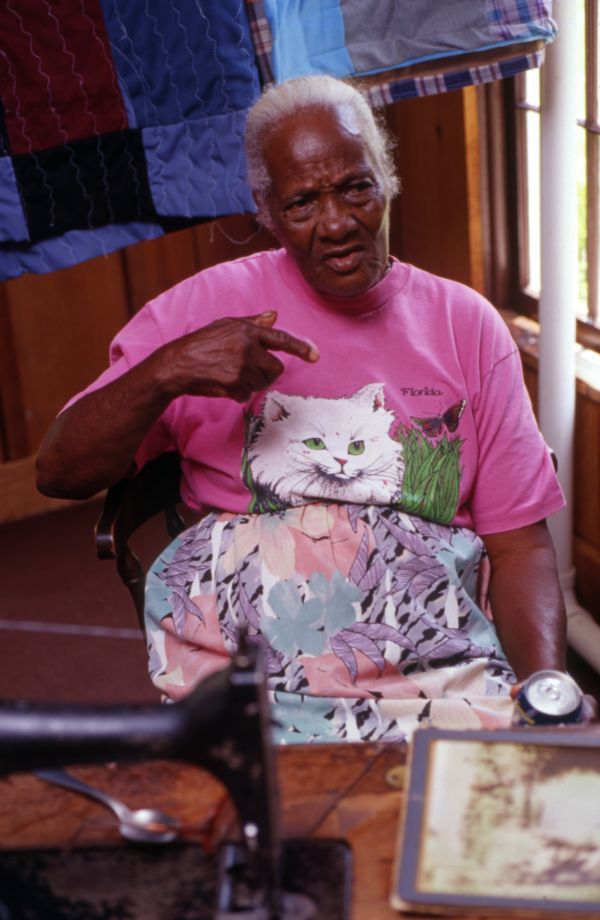
Quilter Sally Jones at the 1995 Florida Folk Festival in White Springs. (State Archives of Florida / FS96034)
S1576
Audio Recordings of Florida Folk Festival Performances and other Folk Events, 1935-2001, 2017, 2019
31.5 gigabytes
This series consists of audio recordings of performances by or interviews with folk musicians, craftspersons, storytellers and folklife interpreters. Most of the recordings document performances by national and local folk personalities at the annual Florida Folk Festival; however, there are also reproductions of Works Progress Administration (WPA) folklore field recordings from the 1930s and 1940s, including recordings by Zora Neale Hurston. Recordings document such areas as children’s lore, foodways, religious traditions, Seminole culture, maritime traditions, ethnic folk culture, material culture and occupational lore. A searchable index is available online through Florida Memory.
S1583
Florida Folklife Archive WPA Federal Writers’ Project Florida Folklore Files, 1935-1943
1.50 cubic feet
The Federal Writers' Project, under the Works Progress Administration, was inaugurated September 28, 1935. This series consists of copies of research gathered in the 1930s and 1940s by the Federal Writers' Project of Florida. The transcripts and edited copies of interviews and field notes document a broad range of folklife subjects relating to Florida's Cracker, Black, Cuban, Seminole and Menorcan communities. Topics include beliefs and customs, folk tales and stories, dialects and jargon, agricultural lore, occupational lore, proverbs, songs, rhymes, cowboy and prison lore, and superstitions. Of special interest are the narratives of formerly enslaved people.
S1585
Florida Folklife Archive Stetson Kennedy Florida Folklife Collection, 1935-1991
7.25 cubic feet
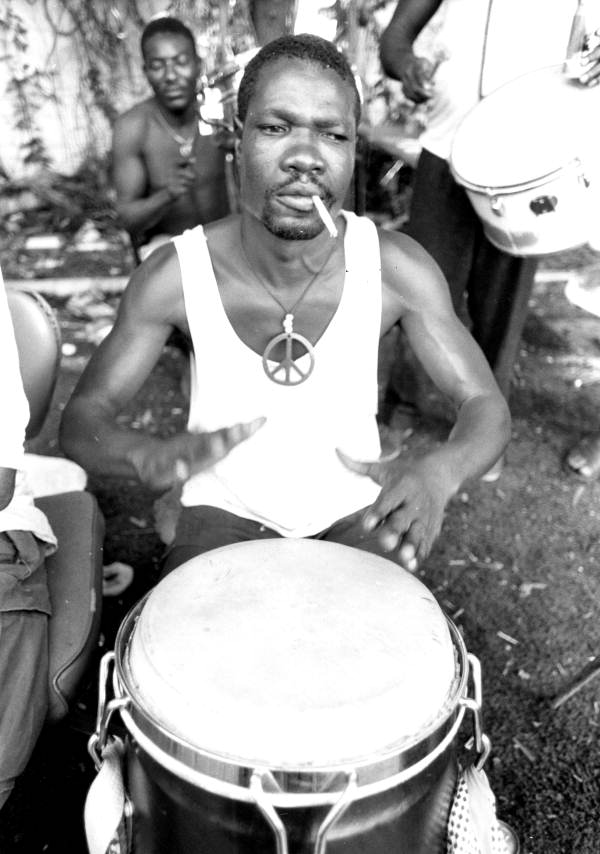
Drummer for Haitian Rara band Konbo Guinyn performs with group - Miami, Florida. (State Archives of Florida / FA5179)
This series consists of originals and copies of materials created and/or maintained by Stetson Kennedy related to Florida folklife. The series includes WPA subject files, WPA school readers, manuscripts and general subject files. The WPA subject files obtained by Stetson Kennedy when the Federal Writers' Project folded in 1943 include interview transcripts and other field notes of WPA writers. The files document the folk tales, songs and art of many different ethnic and cultural groups found in Florida including Greek, Black, Bahamian, Cuban, Menorcan and Cracker. The general subject files are similar to the WPA subject files, consisting of newspaper clippings, articles, bibliographies, research notes, photographs, etc. covering a wide variety of Florida folklife topics and ethnic groups. The series also includes several manuscripts prepared by Stetson Kennedy and/or WPA writers (including Zora Neale Hurston) on various Florida-related topics, some of which, such as "Good Neighbors Across the Tracks" (about the Latin population of Key West and Tampa), and "History of the Negro in Florida," were never published.
S1615
Florida Folklife Archive Video Recordings of Florida Folklife Events, Programs and Television Broadcasts, 1948-1995
393 films and videotapes
This series consists of film and video recordings of performances by, interviews with or documentaries about folk musicians, craftspersons, storytellers, folklife interpreters and various aspects of folklife and folklore in Florida, including Black traditions. Many of the recordings document performances by national and local folk personalities at the annual Florida Folk Festival from 1952 to 1995. Other recordings, including documentaries and shows produced for broadcast television, document other folk festivals and events, folk personalities and traditions, and programs carried out by the Bureau of Florida Folklife Programs, such as Folk Arts in Education activities. These recordings document such areas as children's lore, foodways, religious traditions, maritime traditions, ethnic folk culture, material culture and occupational lore.
S1664
Florida Folklife Archive Florida Folk Festival Fieldwork and Program Planning and Documentation Files, 1983-1995, 1998, 1999
6 cubic feet
This series contains the records compiled by Folklife Bureau staff in researching and planning for the annual Florida Folk Festival, particularly the folklife areas that provide the theme for each year's festival. Photographs, slides, audio tapes, field notes, informant information sheets and one video tape document fieldwork carried out by Bureau staff, including identifying, contacting and interviewing informants, and inviting selected informants to participate as demonstrators or performers at the Folk Festival. The series also includes proposals for and overviews of folklife area themes, photographs and slides of events at the Folk Festivals, and drafts of text and proposed photographic illustrations for the program books distributed at each Folk Festival. Folklife themes documented in this series included ethnic celebrations such as the Jewish observance of Purim, Greek Epiphany and Caribbean Carnival; African and Anglo-Celtic traditions in Florida; the folklife of transportation, including customs,
music, and crafts associated with saddle making, boat building, wheel making and laying of railroad tracks; and the folklife of Central Florida.
S1679
Florida Folklife Archive Folklife Workshops Planning and Documentation
Files, 1986-1995
0.4 cubic foot
This series contains records generated during the planning of Bureau-sponsored workshops in various folk arts and folklife topics. Workshop proposals, research notes, budget estimates, and publicity and registration materials document plans for workshops in such folk arts as traditional fiddle music and dance, leather whip braiding, white oak basketry, Seminole basketry and patchwork, and duck decoy carving. Also included are summary information and final student project videos for "Documenting Your Community Traditions: African American Community Heritage Documentation Workshop" (1995).
S1693
Florida Folklife Archive. Duval County Gospel Music Recordings, n.d.
11 items
These tapes, copied from the originals in the collection of Rev. Robert Brown of Jacksonville, contain recordings of gospel music radio programs, group rehearsals and sermons. Most of the recordings were of the Mt. Ararat Baptist Church.
S1697
Florida Folklife Archive Golden Gospel-Afro American Roots Grant Records, 1985
0.25 cubic foot
The Triumphant Gospel Singers Association of Jacksonville applied for this grant from the National Endowment for the Arts to produce a concert focusing on Black acapella gospel quartet music and “Negro spirituals.” The concert was a memorial to Otis Jackson, a gospel song composer, singer, promoter and radio announcer. This series contains a copy of the grant, correspondence, site evaluation and copies of the gospel concert programs. The programs contain biographies of several gospel quartets and groups.
S1702
Florida Folklife Archive "Drop on Down in Florida" Grant Project Records, 1979-1981
0.25 cubic foot
The "Drop on Down in Florida: Recent Field Recordings of Afro-American Traditional Music"
grant project began in 1979. The major goal of the project was to investigate and promote Florida’s traditional Black music by producing a record album. Peggy Bulger, Brenda McCallum, Stephen McCallum and Dwight DeVane recorded the music. The project was completed in 1980 and the album was released in 1981. This series contains copies of the grant and the booklet from the "Drop on Down" grant project. The booklet discusses the background of performers and the types of music included on the album.
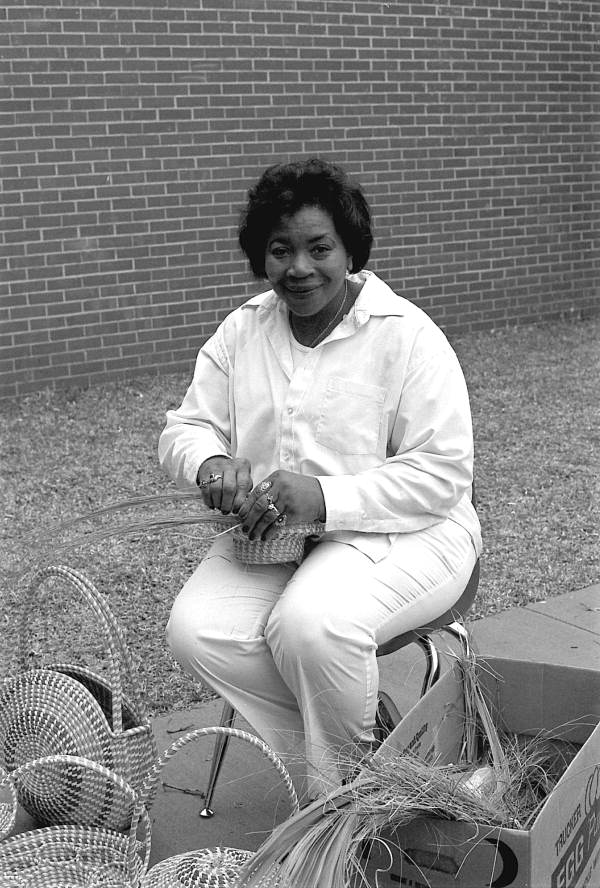
Margaret Garrison makes sweetgrass baskets.(State Archives of Florida / FA5467)
S1703
Florida Folklife Archive Little Galilee Baptist Church Gospel Music Fieldnotes, Audio Cassettes, Negatives and Tape Logs, 1988
0.5 cubic foot
This series documents Black gospel music from the Little Galileo Baptist Church in Mayo and includes two audio cassettes of gospel music and spirituals recorded at the church. It also contains tape logs listing the performers and songs and the photograph and slide log listing the subjects of the photos or slides on the contact sheets.
S1705
Florida Folklife Archive Traditional Sweetgrass Basket Making and Ukrainian Egg Decorating Workshops Records and Slides, 1988-1989
0.25 cubic foot
This series contains the registrations, correspondence, slides, photographs, news releases and biographies of teachers of both the Sweetgrass Basket Making Workshop and the Ukrainian Egg Decorating Workshop held at the Stephen Foster Memorial in 1989. Also included are copies of the information pamphlet and poster. Margaret Garrison of Jacksonville taught the sweetgrass basket making class.
S1709
Florida Folklife Archive Guy Miles Interview Files and Recordings, 1962-1993
10 cubic feet, 1,625 items
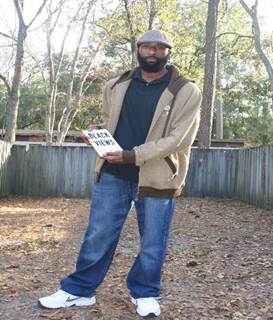
Jamal Jones aka MC Mal holding his father Jamal Abdullah’s book, Black Views. (State Archives of Florida / Series S2359)
S1711
Florida Folklife Archive Callahan Folk Arts Outreach Project Tapes and Photographs, 1993
0.1 cubic foot
This series contains audio recordings and photographs generated by fieldwork undertaken to document the folklife of the Callahan neighborhood of Orlando. Results of the fieldwork were incorporated into the "Folklife of Central Florida" folklife theme area at the 1994 Florida Folk Festival. The tapes and photographs document Black hymn lining and blues, folk tales and children's games.
S1712
Florida Folklife Archive "Women's Contributions" Seminar Audio Tapes and Logs, 1989
0.33 cubic foot
This series contains 14 audiocassette tapes and supporting materials documenting presentations at a Florida Endowment for the Humanities seminar, "Folk Culture in the South: Women's Contributions," held September 29, 1989, at the Jacksonville Museum of Science and History. The seminar featured presentations by Bureau of Florida Folklife Programs staff and area specialists who discussed the study of folk culture; folk traditions in Florida; women's occupational culture and lore; and the folk culture and lore of Hispanic, Jewish and Black women, including customs, beliefs, family and social relations, folk tales and jokes, and musical traditions and styles. The seminar ended with a discussion with and performance by the Versiteers, a Black quartet-style gospel group. In addition to the tapes, the series includes tape logs providing the names of the presenters and the topics discussed on each tape.
S1714
Florida Folklife Archive St. Johns River Survey Fieldwork Files and Tapes, 1982-1985
2.5 cubic feet, 73 audio cassettes 39 reel-to-reel tapes
This series consists of files and audio recordings generated by fieldwork undertaken to document the folklife of the communities surrounding Florida's St. Johns River. The series includes informant information sheets providing name and location of informants and their area(s) of knowledge or skills; field notes providing additional information on informants or on subjects discussed by them; and tape logs listing and describing each performance or subject of discussion on audio tapes of informant interviews, performances or events. Among the subjects discussed are the dance, music, religion
and foodways of Mexican Americans; Black music and religion; and life and culture among these and other populations along the river, including fern growing; fishing, netting and trapping; music, including bluegrass, old time gospel, quartet-style gospel, white gospel, country gospel, bluegrass gospel and blues; crafts and skills such as woodworking, quilting and boat making; cattle ranching; and religion and revivalism.
S1723
Florida Folklife Archive Versiteers Award Ceremony Tapes and Photographs, 1992
0.1 cubic foot, 3 audiocassette tapes
This series consists of audio recordings, photographs and supporting materials documenting a local ceremony held August 21, 1992, in Jacksonville, honoring the Versiteers, a female gospel quartet group and 1992 Florida Folk Heritage Award winners. The ceremony consisted largely of a service at St. James AME Church, including prayers, readings and songs by various clergy and gospel singers and groups, as well as remarks by Florida Folklife Council member Yvonne Tucker and Bureau of Florida Folklife Programs staff member Robert Shanafelt.
S1725
Civil War Recollections of S.M. Hankins, 1861-1865
0.1 cubic foot
This series consists of a 35-page typescript titled “My Recollections of the Confederate War,” transcribed from the original “penciled in longhand in an old account ledger.” Confederate veteran S.M. Hankins wrote the recollections, beginning with Florida's secession in 1861 when Hankins was 14 years old. Hankins recalled Floridians' initial reactions to the threat of war; the raising of military units; the shooting of deserters; the wartime treatment of Black persons; Hankins' enlistment at age 16; escorting prisoners to Andersonville; the Battle of Natural Bridge; and other wartime events. There is no indication of when the transcript was made or how it came to be interfiled with miscellaneous administrative files of the Bureau of Florida Folklife Program.
S2044
Sacred Steel Guitar Recording Project 1993-2000, bulk 1993-1997
0.5 cubic foot, 29 audio tapes
The Sacred Steel Guitar Recording Project originated in 1992 when it came to the attention of Florida Folklife Program folklorist Robert Stone that several predominantly Black House of God churches in the St. Petersburg area were using steel guitars in their religious services. Stone convinced the Florida Folklife Program to apply for a grant to conduct fieldwork and create an album of music for public distribution to increase public awareness of the gospel steel guitar tradition and to document it for future generations. This series contains the administrative and research files for the project, including grant applications and reports, budgets and release forms, audio recordings and field notes for the survey. Also included are materials related to the re-release of the album.
S2359
Lower St. Johns River Basin Survey Records, 2012-2013
54.66 gigabytes, 0.25 cubic foot
This series consists of records generated by the Lower St. Johns River Basin Survey conducted to document the history and culture of the area. Among the records are sound recordings of fieldwork interviews, interview logs, photographs, photograph indices and release forms. Interviewees from the region’s Hispanic and Black communities contributed oral histories as part of the survey. One of the many topics covered in this survey was the rap and hip-hop scene in Jacksonville. Jacksonville emcee Jamal Jones was interviewed during the survey and subsequently participated with his apprentices in the Florida Folklife Program’s Apprenticeship Program.
S2360
Upper St. Johns River Basin Survey Records, 2012-2014
32.88 gigabytes, 0.50 cubic foot
This series consists of records generated by the Upper St. Johns River Basin Survey conducted to document the history and culture of the area. Among the records are sound recordings of fieldwork interviews, interview logs, photographs, photograph indices and release forms. Topics included in the survey include the migrant farmworker labor movement in Florida and public health concerns among farmworkers. Interviewees from the region’s Hispanic and Black communities contributed oral histories as part of the survey.
S2361
St. Johns County Survey Records, 2014-2015
90.49 gigabytes, 0.50 cubic foot
This series consists of records generated by the St. Johns County Survey conducted to document the history and culture of the area. Among the records are sound recordings of fieldwork interviews, interview logs, photographs, photograph indices and release forms. The series includes a report on the historic Black neighborhood of Lincolnville.
S2362
Miami-Dade County Survey Records, 2015-2016
93.61 gigabytes, 0.10 cubic foot
This series consists of records generated by the Miami-Dade County Survey conducted to document the history and culture of the area. Interview participants from Miami’s Cuban, Haitian and African American communities contributed oral histories as part of the survey. Among the records are sound recordings of fieldwork interviews, interview logs, photographs, photograph indices, field notes and release forms.
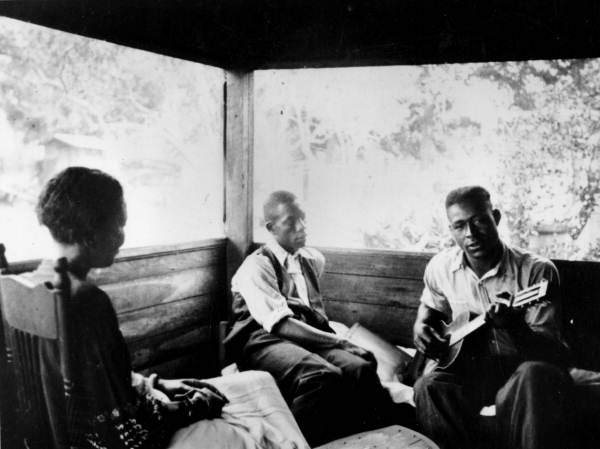
Gabriel Brown playing guitar as Rochelle French and Zora Neale Hurston listen in Eatonville. (State Archives of Florida / FA0514)
S2385
Gadsden Farm Project Records, 2017-2018
155.15 gigabytes, 0.25 cubic foot
This series consists of records created during the Gadsden Farm Project. The records include notes, plans, depositor agreements and participant information forms as well as digital files consisting of interview questions, photographs, oral history video and audio recordings, and a contact spreadsheet. Topics covered in the interviews include farming practices, changes in the farm economy and race relations in Gadsden County.
S2420
Eatonville Oral Interview Tapes, 1996-1997
4 audio tapes
Eatonville, incorporated in 1887, was the first all-Black incorporated town in Florida and the first legally recognized municipality in the United States settled by freedmen. This series consists of audio recordings of interviews with Eatonville residents N.Y. Nathiri, Mike Johnson and Councilmember Theodore Washington. Nathiri, the Executive Director of the Association to Preserve the Eatonville Community Inc., provides considerable information on Eatonville history and her family’s history in the town, beginning with her grandfather in the 1930s.
S2702
Eatonville Survey Records, 2001
0.25 cubic foot
This series consists of records and audio recordings generated by the Eatonville Survey conducted through a grant awarded to the town from the Bureau of Historic Preservation to document Eatonville's culture and history. Records include survey reports, informant depositor agreements and fieldwork data sheets.
S2703
Renaissance Park Living Heritage Festival Video Records, 2001
2 video tapes
This series consists of video recordings generated by the Renaissance Park Living Heritage Festival in Marianna, conducted through a grant awarded to the festival’s founder. The festival was established in 1995 to allow attendees the opportunity to “experience hands-on African American culture traditions and folk ways of life in the early 1900’s in rural Florida.” The grant allowed for the hire of ethnomusicologist and anthropologist Martha Ellen Davis to document Black folklife in Jackson County.
RG 171 Military Department
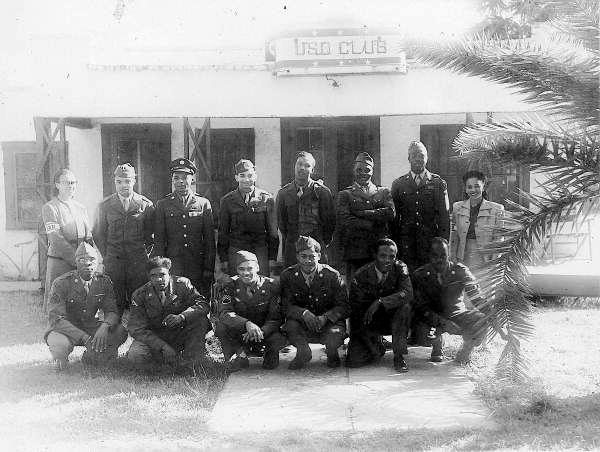
Portrait of the Daytona USO-Black convalescent servicemen. (State Archives of Florida / N049086)
S1204
World War I Army Card Roster, 1924
8 cubic feet, 11 microfilm reels
This series consists of a card roster of Floridians who served in the United States Army during World War I from 1917 to 1919. Each soldier has one or two cards giving information on his or her military service, such as name, serial number, residence, place and date of birth, military organizations he served in, rank, engagements he participated in, wounds or injuries received, dates serving overseas, discharge date, percentage disabled and additional remarks. On the microfilm copy, Black veterans are listed separately from white veterans; officers are listed on Roll 11. Roll 10 contains the cards for promotion or reenlistment.
S1208
Veterans Grave Registration Cards, 1940-1941
0.5 cubic foot, 9 microfilm reels
This series contains a typescript copy of the register of deceased veterans buried in Florida and a microfilm copy of the original note cards used to compile the information. Typescripts list the name, organization, birth and death dates and burial locations of military veterans in each locality. This series is incomplete and does not include typescripts for several counties; however, the microfilmed note cards do include some information for these counties. Note cards contain additional information on veterans, including race and next of kin.
S1344
Summary of Florida Veterans of World War I, 1925
3 volumes
This series contains a summary of the citizens of Florida who served in the U.S. military during World War I. Records list the name, race, service period, branch of service, rank, killed or wounded status and awards earned for each veteran.
S1425
Florida Military Department Historical Records, 1860-1945
2.5 cubic feet
This series contains historical information that illustrates the participation of Florida's Militia, National Guard and private citizens in the wars of the United States. These records include casualty notices, correspondence and statistical reports generated at the Florida Adjutant General's Office and the service departments in Washington, D.C. Much of the correspondence deals with the U.S. Civil War, Spanish-American War and World War I. Material that covers later wars is mostly in the form of official casualty notice releases from either the Office of War Information or the U.S. Department of Defense. The series includes a folder of records related to the Liberty City riots of 1980.
S1433
Veterans’ Death Notices, 1942-1960
1 cubic foot
This series consists of cards listing veteran deaths. These cards contain the name of veteran, serial number, last known address, location of death, information of next of kin, date and place of birth, race, date and cause of death, date of burial or disposal or remains, cemetery, branch of service and rank, dates of service, date of discharge, foreign service (if any), and name of funeral director.
RG 172 Adjutant General's Office
S1142
World War I Induction Records of Floridians, 1917-1918
6.5 cubic feet
The series contains lists of men called into service during World War I. The records generally include the race of the inductee, his address and the date of his induction call-up. Some lists include the individual occupations of the inductees and information on whether the individual was ultimately accepted for military service.
S1146
Muster Rolls and Supporting Documents, 1870-1918
10 cubic feet, 6 microfilm reels
This series contains muster rolls and supporting documents of the Florida State Militia, the Florida State Troops and the Florida National Guard. The muster rolls in this series are the only known surviving listings of the Floridians who served in the State Militia, the State Troops and the National Guard during this era. This series includes several rolls for organizations that comprised Black enlisted men and officers.
RG 192 State Planning Board
S1653
Florida Recreational Facilities Survey, 1938
0.25 cubic foot
This series contains the results of a survey of recreational facilities in Florida as executed by the U.S. Work Projects Administration (WPA). The survey indicates the locations and various types of facilities in use at the time, such as golf courses and movie theatres. The survey notes some facilities as segregated by race or sex.
RG 350 State Comptroller
S28
Tax Rolls, 1829-1898
127 cubic feet, 5 volumes
The county tax assessor annually prepared a copy of the tax rolls for the Comptroller and the Territorial Auditor, used for collecting taxes authorized by the Florida Legislature. From 1829 to 1852, only state taxes were entered on the assessment roll. Beginning in 1853, the rolls provided columns for the calculation of both state and county revenue and by 1869, the breakdown also included revenue allocated for county and state school funds. The early tax records document the number of enslaved Black persons in possession of each taxpayer. The format of these ledgers changed as new comptrollers took office. Generally, the records differentiate whether a taxpayer is a free person of color or white and within a certain taxpaying age range. Later rolls following the Civil War widely list taxes paid by freedmen.
S556
Revenue Records, 1841-1906
1 cubic foot, 3 volumes
The series contains different types of revenue records maintained by the Comptroller's Office documenting the various duties of the Comptroller as collector of revenues. One volume contains the tax records for the freedman common school fund from 1866 to 1868, showing the collection of a poll tax from freedmen.
RG 360 Department of Commerce
S389
Rural Equal Opportunity Program Records, 1975-1976
2 cubic feet
The Rural Equal Opportunity Program was established in September of 1975 by a grant under the United States Comprehensive Employment and Training Act. The Department of Commerce staffed and jointly administered the program with the Department of Administration. The program's objective was to increase employment opportunities in state agencies for disadvantaged, low income and underemployed rural citizens residing in a 12-county pilot area of Madison, Jefferson, Wakulla, Gadsden, Liberty, Franklin, Gulf, Calhoun, Washington, Walton, Jackson and Holmes counties. The program was terminated in June 1976. The series includes records related to affirmative action.
S422
Office of the Deputy Secretary Subject Files, 1970-1975
2.5 cubic feet
The series contains correspondence, reports, memoranda and minutes of meetings documenting programs conducted by the Department of Commerce and covering subjects such as minority businesses.
S429
Administrative Files, 1972-1977
13 cubic feet
This series contains files that reflect the administrative functions of the Office of the Secretary and deal with such subjects as personnel, leasing, minority business, equal employment opportunity, the Comprehensive Employment and Training Act program (CETA), the Florida Agricultural and Mechanical University Council of Sponsors and the interpretation of department policy in response to public inquiries. The files contain correspondence, memoranda, reports and other records.
S1516
Small Business Development Program Files, 1984-1986
1 cubic foot
This series documents the activities of the Division of Economic Development and the Division of Tourism and pertains primarily to small and minority business programs operated by the Division of Economic Development. The bulk of the records document the Florida Small Business Development Center program. The records consist of correspondence, reports, minutes and memoranda.
RG 370 Department of Labor and Employment Security
S1896 Diversity Council Records, 1995-1997
0.25 cubic foot
The Diversity Council was formed on February 6, 1995, by Secretary of Labor Douglas Jamerson. It consisted of 15 members selected from all levels of the department and from each of its divisions. The council was responsible for reviewing and recommending administrative services and educational programs addressing issues of discrimination, civil rights, minority business enterprises, access to opportunity and managing diversity. The group also reviewed affirmative action requirements, developed departmental diversity training programs and recommended management strategies for eliminating equal opportunity barriers.
RG 372 Division of Employment Security
S428
Equal Employment Opportunity Office
Administrative Files, 1965-1976
6 cubic feet
The series documents the administration of equal employment opportunity policies and programs for minorities and the investigation of reports of job discrimination in Florida. The records include correspondence, reports, program data and reference materials.
RG 400 Department of Education
S253
Associate Commissioner
Administrative Files, 1956-1971
16.25 cubic feet
This series includes reports, minutes, surveys, correspondence and other records documenting such topics as textbook adoption, school desegregation and the Civil Rights Act.
S255
Division of Administration and Finance
Records, 1940-1971
40.75 cubic feet
This series includes correspondence, agendas, maps, surveys and reports concerning such topics as conferences, transportation, school funding, federal regulations and the Civil Rights Act.
S257
Division of Instruction Subject Files, 1932-1945, 1968-1971
7.75 cubic feet
This series documents the activities of the deputy commissioner of the Division of Instruction, who oversaw the administration of various programs and acted as a "troubleshooter" for the commissioner. The series includes correspondence, memoranda and other records relating to topics such as curriculum plans, National Youth Administration, National Education Association, Black high schools and segregation.
S1778
Federal School System Reports, 1925-1970
0.6 cubic foot
This series consists of statistical reports on Florida's public school system compiled by the Florida Department of Education and then submitted to the United States Office of Education. Prior to 1955, there were two set of reports: Combined, "White and Colored" or "White and Negro," and "Colored" or "Negro." Each set recorded personnel statistics, such as number of administrative officers, supervising officers, teachers and pupils; average daily attendance; number of schools; financial statistics, such as income from permanent funds; leases of school lands; salaries of supervisors and teachers; supplies and other expenses; and status of retirement funds. Since 1955, the report was no longer divided by race. The series also contains federal school report instructions and correspondence from 1936 to 1954 between officers of the United States Office of Education and officers of the Department of Education concerning the process of the federal school reports.
RG 401 Florida Public Broadcasting
S1564
Rosewood Claims Bill Hearings Videotapes, 1994
27 items
These videotapes document hearings held in 1994 on House Bill 591, a claims bill for compensation for survivors and their families of the Rosewood incident of 1923. After a young white woman claimed she was assaulted by a Black man who allegedly then fled toward Rosewood, a small, mostly Black community about 40 miles west of Gainesville, a white mob attacked the community, hanged or shot several residents, and burned all its buildings to the ground. The rampage continued for a week, resulting in the deaths of six Black persons and two whites and the permanent evacuation of all residents of Rosewood.
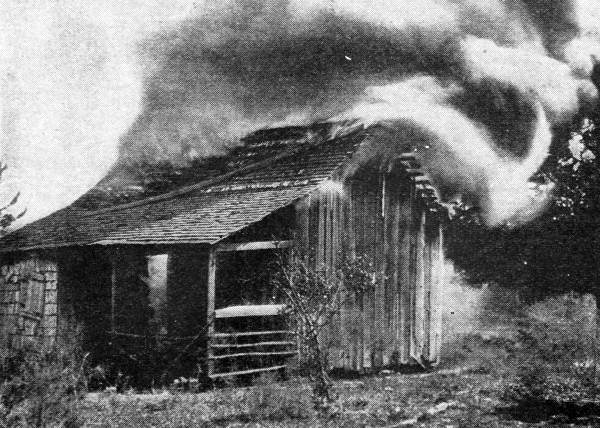
Deliberate burning of an African American home, possibly in Rosewood. (State Archives of Florida / RC12409)
Witnesses at the hearings included victims and their descendants and experts in psychology and economics. Testimony described the families who lived in Rosewood, the houses and other buildings in the town, the events of January 1, 1923, and the psychological and economic impact of the events on the victims and their families. Also included in the series are videotapes of proceedings of the House and Senate Appropriations Committees regarding the Rosewood claims bill.
S2192
Florida Governmental Affairs Broadcast Audio and Video Recordings, 1976-2003
3,524 audio tapes, 796 video tapes, 146 compact discs
This series includes audio and video recordings of government affairs programs as well as local and statewide news programs broadcast by WFSU. Programs include Florida on the Line, Capital Report, People’s Editorial and Florida Crossroads as well as recordings of call-in shows with the governor, inaugurations and openings of the Florida Legislature. These programs cover a myriad of topics relevant to Black history, including the Rosewood Massacre.
RG 402 Commissioner of Education
S249
Superintendent of Public Instruction Correspondence, 1882-1922
2.25 cubic feet
This series contains the administrative correspondence of the Superintendent of Public Instruction, except for that from William M. Holloway from 1905 to 1913. Correspondence reflects the superintendents’ involvement in all matters pertaining to public instruction, such as inspection reports of the State Rural School Inspector, summer school, child training schools, state hospitals and correctional institutions.
S306
Department of Education Commissioner of Education Floyd T. Christian County Education Issues Files, 1966-1974
9 cubic feet
This series contains Commissioner of Education Floyd T. Christian’s correspondence with the Department of Education, citizens, the county school boards and county superintendents. Some correspondence concerns integration issues, the 1968 teacher walkout and other major education issues.
S1129
Department of Education Commissioner of Education Floyd T. Christian Federal Education Programs Files, 1966-1973
5 cubic feet
The series includes correspondence, reports, memoranda, studies and other materials relating to federal education programs such as the National Defense Education Act, the Economic Opportunity Act and the Elementary and Secondary Education Act of 1965. The Civil Rights Act of 1964 is among the issues covered in this series.
RG 441 Board of Regents, Office of the Chancellor
S829
Chancellor Robert B. Mautz Equal Educational Opportunity Files, 1973-1974
2 cubic feet
The series contains correspondence, surveys, reports and other materials related to the Equalizing Educational Opportunity in Higher Education Plan. The Board of Regents prepared the plan to put the State University System in compliance with Title VI of the Civil Rights Act of 1964 and with the order of the United States District Court, District of Columbia to the Department of Health, Education and Welfare, in Adams v. Weinberger.
RG 442 State University System of Florida, Vice Chancellors’ Offices
S844
Office of Student Affairs Reference Files, 1972-1978
18 cubic feet
Reference files of the Vice Chancellor of Student Affairs include correspondence, memoranda, travel vouchers, purchase orders, supply orders, minutes of meetings, plans and studies. Subjects include desegregation plans, Florida State University's Black Student Union and student organizations.
RG 443 State University System of Florida
S1268
Office of Equal Educational Opportunity Programs University Visitations Files, 1983-1986
2 cubic feet
The series contains the files of Special Assistant to the Chancellor for Equal Education Opportunity Programs Delores Auzenne. It consists of correspondence, reports and materials related to the on-site visits to the nine Florida public universities, the recommendations of the EEO Advisory Committee, and the responses from the universities. Also included are the plans and actions taken by each university to enhance affirmative action in employment and educational opportunities for minority students.
RG 452 University of Florida
S1958
Florida State Museum State Park Exhibit Files, 1955-1972
1.25 cubic feet
This series contains records concerning the various sites and exhibits maintained by the Florida State Museum for the Florida Park Service. Most of the records relate to the Kingsley Plantation on Fort George Island. The series also includes some primary source-based historical research relating to the preservation and interpretation of the Kingsley Plantation and other state-owned historical sites.
RG 493 Superintendent of Common Schools for Freedmen
S288
Superintendent of Common Schools for Freedmen Report, 1866
0.25 cubic foot
This series contains the 1866 report of Superintendent E.B. Duncan. The report is a pamphlet that states the activities of the superintendent in educating Florida's freedmen.
RG 496 State Department of Education
S297
Ledgers, 1859-1967
12 Volumes
Bound ledgers of the State Department of Education and its predecessor agency, the Department of Public Instruction, consist of fiscal and administrative materials covering a variety of financial transactions. They document the apportionment of federal and state funds to county school systems and state institutions of higher learning. When separate schools and colleges for white and Black students existed, the financial records list the appropriations as for "White" and "Colored" or "Negro" schools and teachers.
RG 510 Division of Recreation and Parks
S2034
Florida Folk Festival Audio Recordings, 2002-2004, 2006-2017, 2019
1.3 cubic feet, 1392 compact discs, 14.23 gigabytes
This series consists of audio recordings of performances collected by the Florida Park Service from the Florida Folk Festival as well as supporting documentation and release forms. A searchable index to images and sound recordings is available online through Florida Memory.
RG 521 Water Management Districts
S2347
Oral Histories of the Apalachicola River, 2001-2006
2.5 cubic feet
This series consists of the oral histories conducted by the Northwest Florida Water Management District for the book Voices of the Apalachicola. The series contains the recordings and transcripts of the interviews, interviewee agreements and correspondence. The oral histories document the lives of people who lived, worked and contributed to the culture of the Apalachicola River and Bay basin, including Edward Tolliver, the first Black mayor of Apalachicola, and Joseph McMillan Sr., a member of the Black community who worked in the railroad and timber industries in the region.
RG 599 Spanish Archives - Many of the records in this record group are in Spanish.
S979
East Florida Papers, 1737-1858
175 microfilm reels
The series contains a microfilm copy of the East Florida Papers, the archives of the Spanish administration during its "Second Occupation" of East Florida. Most of the records were created between 1783, when Britain returned possession of Florida to Spain, and 1821, when American authorities took possession of the area as a territory. The papers contain information on the Spanish government's dealings with the United States and with Mexico; The British trading company Panton, Leslie & Company; prisons; vessels and cargoes; fortifications and defense; and criminal proceedings. Also included are letters to and from the commander of the Colored Militia (1812-1821) and records described by their creators as pertaining to “Negro Titles, Runaways, etc.” (1737-1805).
S990
Board of Land Commissioners Confirmed Spanish Land Grant Claims, 1763-1821
17 cubic feet, 1,806 microfiche, 7 microfilm reels
The series consists of "dossiers" containing papers filed in evidence and confirmed as valid claims before the Board of Land Commissioners. Each land claim with its supporting documents was later encased in a manila jacket on which appears the name of the applicant, the number of acres claimed, and disposition of the claim and page reference to the American State Papers. The supporting documents include petitions or memorials to a governor for land; grants; attests; plats; deeds of sale, gifts, wills, bequests and exchanges; applications; and translations of Spanish documents. Some files include lists of enslaved persons held. For example, the folder for Antonio Suarez (1807) includes lists of enslaved persons with names, ages and the designations "Negra," "Negro" and "Mulatto."
S991
Board of Land Commissioners Unconfirmed Spanish Land Grant Claims, 1763-1821
5 cubic feet, 565 microfiche
This series consists of "dossiers" like those in series S990 containing papers filed in evidence but not confirmed as valid claims before the Board of Land Commissioners.
S992
Board of Land Commissioners Memorials and Concessions, 1786-1821
6 cubic feet, 1,600 microfiche
The series contains memorials or petitions to the governor for confirmation of the petitioner's right to ownership of land under the required conditions set forth by the Spanish government. A number of the petitions are filed by free Black or biracial landowners and many of the petitions, by either these or white petitioners, describe free or enslaved Black and/or biracial persons living on the land in question.
S993
Board of Land Commissioners Memorials for City Lots in St. Augustine, 1764-1821
1.5 cubic feet, 2 microfilm reels
This series consists of memorials or petitions to the governor for confirmation of city lot ownership in St. Augustine when the United States acquired Florida from Spain. Also included are other documents relating to claims in St. Augustine including deeds to town lots, an index to land, inventory of lots and the Day Docket of the Board of the Land Commissioner. Some records in this series are claims files by Black persons and other people of color.
S995
Minutes and Testimony Taken Before the Board of Land Commissioners for East Florida, 1823-1825
0.5 cubic foot, 1 microfilm reel
This series contains the minutes of Board of Land Commissioners for East Florida from March 29, 1824, to December 20, 1825, and testimony taken before the Board from December 11, 1823, to December 28, 1825. Claims from Spanish landowners sometimes contain information on enslaved persons of color and, less frequently, may come from free persons of color, some of whom also indicate their own enslavement of other persons of color.
S997
Concessions for New Settlers, 1791-1821
0.5 cubic foot, 2 microfilm reels
This series contains land concessions filed with the Board of Land Commissioners as evidence of settlement of lands in East Florida. These concessions were granted by virtue of the Royal Order communicated to the Spanish government on October 29, 1790, and were bestowed from 1791 to 1821 to entice new settlers to move to Florida. This series includes a name index.
S1001
Record Books, 1773-1828
431 microfiche
This series contains the record books of the Board of Land Commissioners for East and West Florida. Records include minutes, registers of claims, copies of grants, concessions, memorials, surveys and decrees. This series also contains copies of royal titles, deeds of mortgage, sales, concessions and judicial tax sales in St. Augustine.
S1022
Protocols, 1804-1819
0.75 cubic foot, 1 microfilm reel
This series contains various Spanish protocols - a summary documents or minutes of meetings verified for accuracy- or legal instruments relating to land claims submitted to the Board of Land Commissioners. Records include wills, deeds, titles, testimony and bills of sale.
S1023
Miscellaneous Spanish Florida Land Records, 1804-1849
1.5 cubic feet, 2 microfilm reels
This series contains several types of land records related to the Spanish land grant claims submitted to the Board of Land Commissioners. Included are documents of private claims of individuals; abstracts of claims to lots in Pensacola and records related to claims in West Florida; descriptive lists; docket of claims; land surveys; and correspondence. Many of these records contain references to enslaved Black and biracial persons or free people of color.
S1232
Surveys of Spanish Land Grants, 1791-1836
0.5 cubic foot, 1 microfilm reel
This series contains the original survey plats of Spanish land grants in East Florida, most dating from 1791 to 1820. The records, consisting of a plat drawing of the land grant and a description of the boundaries, were filed with the Board of Land Commissioners as evidence of petitioner’s right to ownership of land under the required conditions set forth by the Spanish government. Plat maps can be used as corroborating documentation in regard to records available in the other series in this record group.
S1235
Memorials and Concessions Not Acted Upon, 1786-1821
0.5 cubic foot, 1 microfilm reel
This series documents those Florida Spanish land claims in East Florida that were not acted upon by the Board of Land Commissioners. Records include memorials and concessions made by the Spanish governor to individuals in Florida, later filed with the Board as evidence of petitioner’s right to ownership of land in the territory. Although not legally acted upon, these records contain valuable information about the claims and possessions of Spanish Florida citizens, including enslaved and free people of color.
RG 630 Florida Department of Juvenile Justice
S1849
Agency Head Records, 1993-2009
36.75 cubic feet
This series contains reports, correspondence, reading files, speeches and surveys created by or sent to the secretary or deputy secretary since the creation of this department as an independent agency. Subjects range from general administration to the administration of juvenile justice and its relationship to juvenile corrections. Some records are included from the department's predecessor agency, the Division of Juvenile Justice, Department of Health and Rehabilitative Services, and address the same issues. The series includes records covering Black business associations, the legislative Black conference, minority overrepresentation, the National Forum for Black Public Administrators, the Black State Legislators Conference, the NAACP, FAMU’s Aftercare Program for Juvenile Justice, Racial Profiling, and the Martin Lee Anderson Lawsuit.
S2241
Florida School for Boys
Photographs, ca. 1920s-2010
4.75 cubic feet
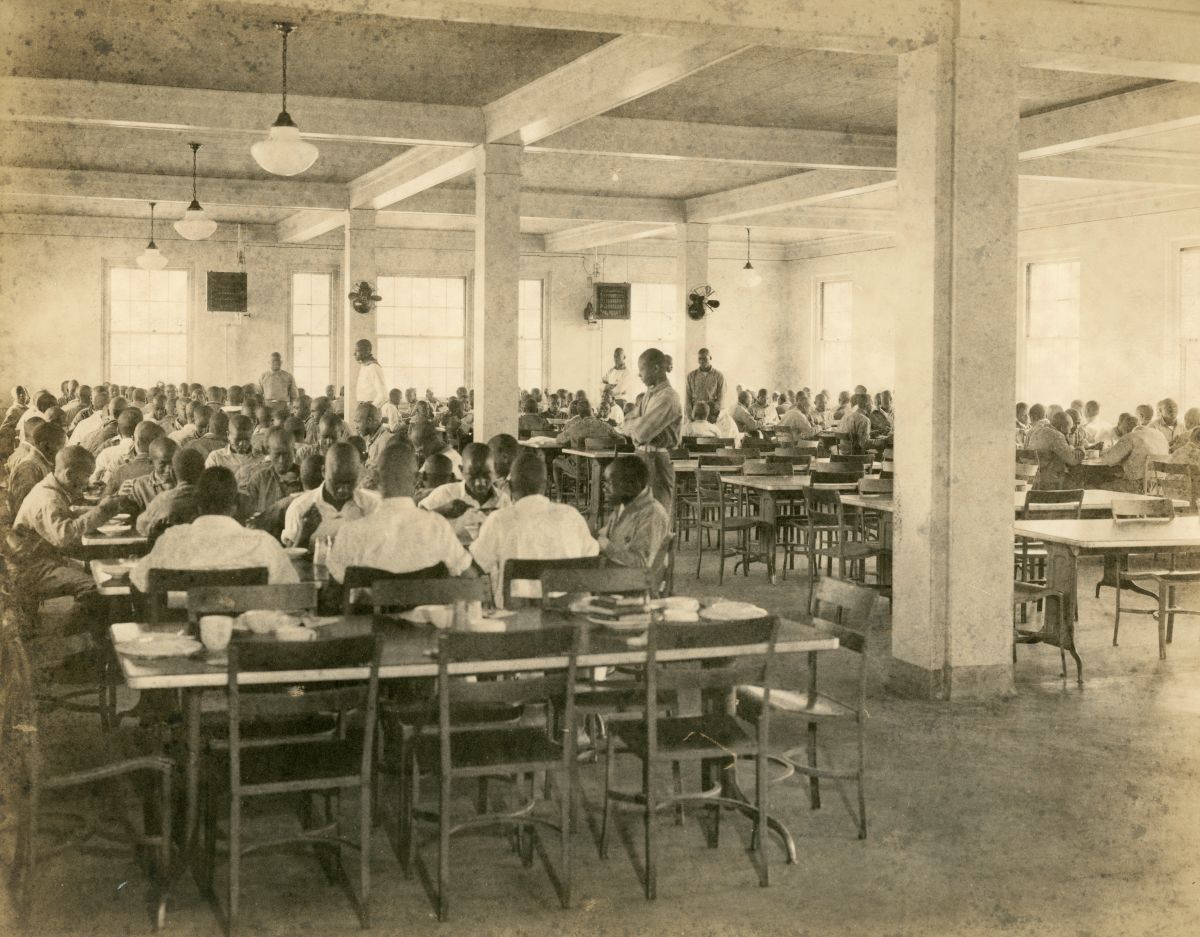
African American boys in dining hall at the School for Boys in Marianna, Florida. (State Archives of Florida / DSB0150)
This series consists of photographs depicting residents, staff, facilities, programs and activities of
the Florida School for Boys, commonly known as the Dozier School for Boys, which was segregated until 1966. Images include boys in classrooms and participating in training and activities relating to sports, music, agriculture, mechanics, etc., as well as interiors and exteriors of campus buildings. The series features photography from the school depicting African American boys tilling with a tractor, African American dormitory and campus scenes, and the African American dining hall.
S2256
Florida School for Boys
Student Ledgers, 1915-2011
32 volumes
This series contains the listing of all juvenile offenders received into the Florida School for Boys, commonly known as the Dozier School for Boys. The ledgers have separate sections for white and Black juveniles and include the name, sex, race, age, birth state, offense, sentence, dates of arrival and release, whether they escaped (date of escape and recapture, if any), prison identification number, and the manner of termination of residence, i.e., end of sentence, pardon, death, etc.
S2323
Florida School for Boys (Okeechobee, Fla.)
Intake and Discharge Ledgers, 1959-1985
7 volumes
This series contains the listing of all juvenile offenders received into and discharged from the Florida School for Boys at Okeechobee. The ledgers include the name, prison identification number, county of residency, number of boys present and dates of arrival or release. The daily ledgers also document escapes, recaptures, furloughs and recommitments.
S2324
Florida School for Boys (Okeechobee, Fla.)
Intake and Discharge Ledgers, 1959-1968, 1981-1985
2 volumes
This series contains the listing of all juvenile offenders received into the Florida School for Boys at Okeechobee. The ledgers include the name, sex, race, age, birth state, offense, sentence, dates of arrival and release, whether they escaped (date of escape and recapture if any), prison identification number, and the manner of termination of residence, i.e., end of sentence, pardon, death, etc. The records’ creators segregated the ledger entries by race.
RG 650 Department of Legal Affairs
S1790
Florida Commission on the Status of Women Florida Women's Hall of Fame Nomination Files, 1992-1997
6.25 cubic feet
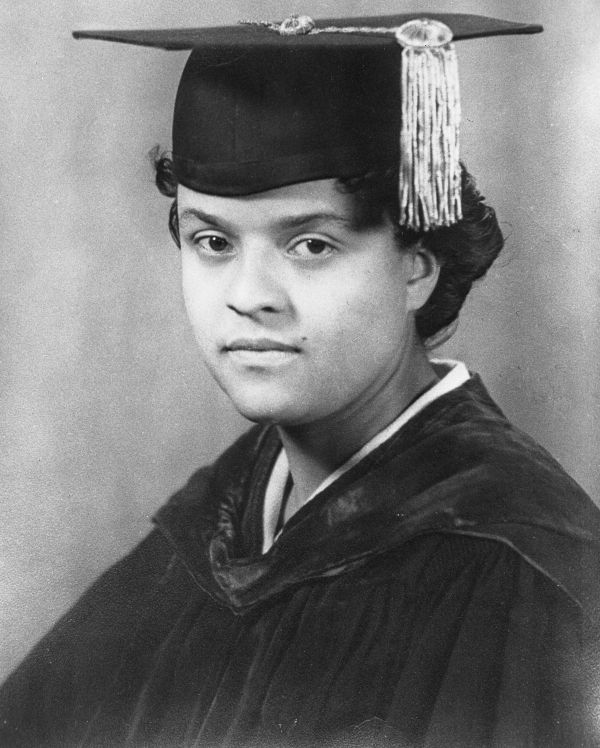
Evelyn Stocking Crosslin, 1940. (State Archives of Florida / N035237)
This series documents the nomination and selection process of candidates for the Florida Women's Hall of Fame. It contains nomination forms, correspondence, letters of recommendation, memoranda, biographies, news clippings and press releases that pertain to each nominee. Black inductees in this period include Carrie P. Meek, Gladys D. Milton, Evelyn Stocking Crosslin and M. Athalie Range.
S2021
Florida Commission on the Status of Women Reporting and Issue Files, 1995-2005
10 cubic feet
This series documents issues that the Commission on the Status of Women researched and/or reported on, such as Florida's domestic violence laws, pay equality, elder care and abuse, women's health issues, women's history month and programs and facilities relating to young and teenage girls incarcerated in Florida's juvenile justice system. This series contains correspondence, memoranda, House and Senate bills and legislative agenda, budget requests, expenditure records, agency reports, program surveys and evaluations, and monthly Commission executive director reports. Box 6 contains articles on Mary McLeod Bethune and Zora Neale Hurston.
S2268
Urban League Grant Program Files, 1988-2007
2.5 cubic feet
This series documents crime prevention programs conducted by the Florida Consortium of Urban League Affiliates under grants administered by the Bureau of Criminal Justice Programs. The series includes agreements between the State of Florida and the consortium under which Urban League agencies provided programs and services aimed toward statewide crime prevention and intervention in general, with an emphasis on reducing violent crime rates within African American communities. The series also includes quarterly and final evaluation reports detailing the programs, activities, progress, outcomes and expenditures under each grant, as well as audit reports and financial statements of the programs and the agencies conducting them.
RG 670 Department of Corrections
S500
Prison Registers, 1875-1959
13 volumes, 2.25 cubic feet, 1 microfilm reel
This listing of all convicts received into the state prison system provides each prisoner's name, sex, race, age, birthdate, birth state, crime, sentence, date of release, prison number and how residence terminated, including end of sentence, pardon, death, etc. Select records from this collection have been digitized and are available on the Florida Memory website.
RG 800 Department of Health and Rehabilitative Services
S1571
Florida Combined Indexes of Marriages, Divorces and Deaths, 1877-1997
4,000 microfiche
This series consists of microfiche copies of the combined indexes to Florida marriage, divorce and death records maintained by the Office of Vital Statistics. The indexes cover marriages from 1927 to 1997; divorces from 1927 to 1942 and 1970-1997; and deaths from 1877 to 1997.
RG 841 Florida State Hospital
S1062
Commitment Records, 1893-1973
321 cubic feet
This series documents the procedure by which persons were committed to the Florida State Hospital and its predecessor, the Florida Hospital for the Insane. The records end in 1973 when the “Baker Act” was passed, eliminating the need for a separate commitment record. Early records contain a copy of the official court record, titled “Insanity. Commitment to Asylum,” which includes information such as cause of illness, resulting condition and any correspondence regarding commitment. Later records contain primarily routine court documents, although some correspondence is present.
Medical Records, 1914-1983
179.50 cubic feet
The series contains medical records of patients who died while hospitalized or were discharged from the Florida State Hospital and its predecessor, the Florida Hospital for the Insane. The post-1938 records are sample cases of selected medical records. The medical records contain charts; admission, furlough and discharge papers; progress notes; and other information pertaining to the patient's hospitalization and treatment. The 1914-1938 files are subdivided into black females, black males, white females and white males.
S1064
Daily Reports, 1918-1979
31 volumes, 0.75 cubic foot
This series contains daily reports of patients at the Florida State Hospital and its predecessor, the Florida Hospital for the Insane. The reports contain a daily statistical accounting of the movement of psychiatric patients, including admissions, discharges, furloughs, escapes and deaths. Statistics are broken down by patient race and sex.
S1068
Federal Census for Public Mental Hospitals Reports, 1933, 1942-1962
1.5 cubic feet
This series contains statistical reports prepared by the Florida State Hospital for submission to the federal government for the Census for Public Mental Hospitals. The 1933 reports contain information such as name, race, sex, date of admission, length of time in hospital and diagnosis for individual patients. The records from 1942 to 1962 are in draft form and do not contain individual names, but rather give statistical counts by age at admission and by several categories of mental health conditions.
S1070
Hospital Reports, 1923-1961
1 cubic foot
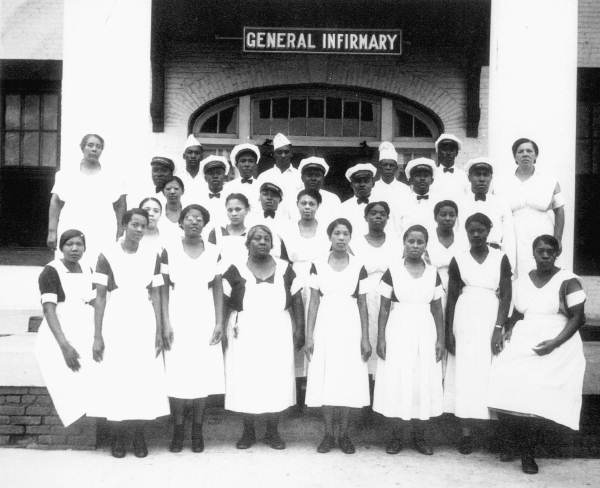
Staff at the Florida State Hospital - Chattahoochee, Florida (State Archives of Florida / RC13892)
This series contains hospital reports from the Florida State Hospital, generated by ward and hospital administrators each month to summarize their activities. Statistics, divided by sex and race, document the number and types of patients and their treatment and care. These reports summarize information submitted on the activities of the general hospital, including the operating room, the X-ray and physiotherapy departments, the tuberculosis hospital, the insulin and electroshock therapy wards, and the ward dressing rooms.
S1079
Discharges, 1901-1922
1 cubic foot
This series contains discharge documents for patients at the Florida State Hospital and its predecessor, the Florida Hospital for the Insane. Patients were discharged for various reasons, including transfer to another institution, recovery or release to their home. Discharges contain patient information such as name, race, county of residence, dates of hospital stay and, in some instances, condition of the patient upon discharge.
S2661
Mortician Ledgers and Cemetery Records, 1835-1932
0.5 cubic foot
This series contains photocopies of mortician ledgers and cemetery records compiled in the operation of the Florida State Hospital and its predecessor, the Florida Hospital for the Insane. The mortician ledgers in this series date from 1909 to 1932 and record the names of the deceased, the dates and locations of deaths (some were furloughed patients away from the hospital) and the method of disposition of the remains by the mortician. Some patients were buried on the grounds of the hospital, while others were sent elsewhere in the state for burial. Cemetery records date from 1835 to 1931 and note the plot sections and grave numbers of the named individuals buried on hospital grounds.
RG 865 Department of Economic Opportunity
S2376
Agency Director Subject Files, 1993-2003, bulk 1999-2001
6.5 cubic feet
This series consists of records created and maintained by the Executive Director's Office within the Department of Economic Opportunity. It primarily consists of correspondence with the department's executive staff, the governor and others regarding corporate and small business development in Florida. The records document the various actions and responsibilities of that office, including administration of state and federal projects, management of public-private partnerships and state agencies, workforce development, and international trade and business cooperation. The series includes records from the Black Business Investment Board, 1998-2000, Black enterprises, from 1999-2000, and minority business from 1999-2000.
RG 891 Florida Commission on Human Relations
S382
Records, 1969-1976
1 cubic foot
Records of the Commission on Human Relations include minutes, agenda, correspondence, program proposals and news releases documenting the Commission's recommendations on civil rights issues, including equal opportunity, race relations, affirmative action and job discrimination. More specifically, the records of the Commission reflect its plans for desegregation in the schools and in public accommodations. Correspondence on the Miami Crisis, or riots, of 1969 includes a review and analysis of the situation. A transcript of the July 1, 1978, meeting, documents Al Featherton, leader of the Black Afro Movement, addressing the Commission on the Miami Crisis about racial conflicts. Other significant files are those relating to the Civil Rights Act of 1964, the Key West disturbances and the Fort Pierce investigations.
RG 893 Florida Agricultural and Mechanical University Hospital
S438
Daily Medication Logs, 1952-1961
12 volumes
The Florida Agricultural and Mechanical University Hospital operated from 1950 to 1970 as the major health care facility for all Black students, faculty and residents within a 160-mile radius of Tallahassee. It opened in 1911, serving as the sanatorium, student health center and training center for black nurses of the Florida Agricultural and Mechanical College for Negroes. This series documents the medications given to patients in general, surgery, the emergency room and obstetrics ward. The volumes list the name of the patient, type of medication, date, time and doctor.
S439
Birth Certificate Receipts, 1948-1958
2 cubic feet
The series consists of receipts for the birth certificates issued by the hospital. The receipts include the date and place of birth, parents' names and occupations, and other birth information as given on the birth certificate. Records for 1948 are incomplete, and no records for 1949 are included.
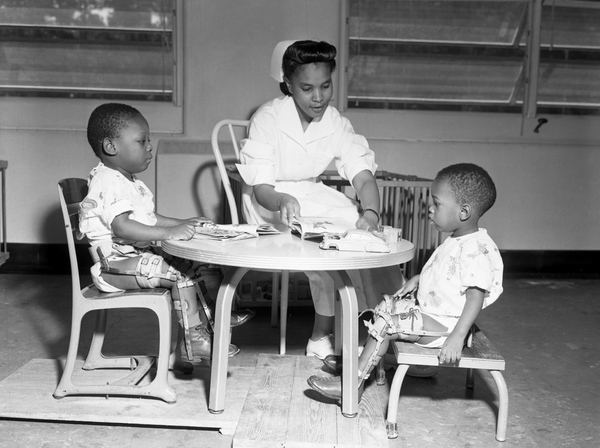
Nurse Grace Kyler working with polio victims at the FAMU Hospital in Tallahassee. (State Archives of Florida / TD00035)
S440
Hospital Registers, 1943-1967
62 volumes
Hospital registers are of several types including emergency and accidents, delivery room, autopsy reports, recovery room, pediatrics, medical and operating room. Typical form fields found in these records include but are not limited to date, [patient] no., time of arrival, whether an ambulance was used or not, full name, age, religion, nationality, marital status, occupation, cause of accident, nature of injuries, and treatment.
S441
Death Records, 1953-1967
1 cubic foot, 3 volumes
Records documenting the deaths of hospital patients include original death reports with name, date of death, age and cause of death, and indexed death register volumes.
S442
Administrative Files, 1950-1963
2 cubic feet
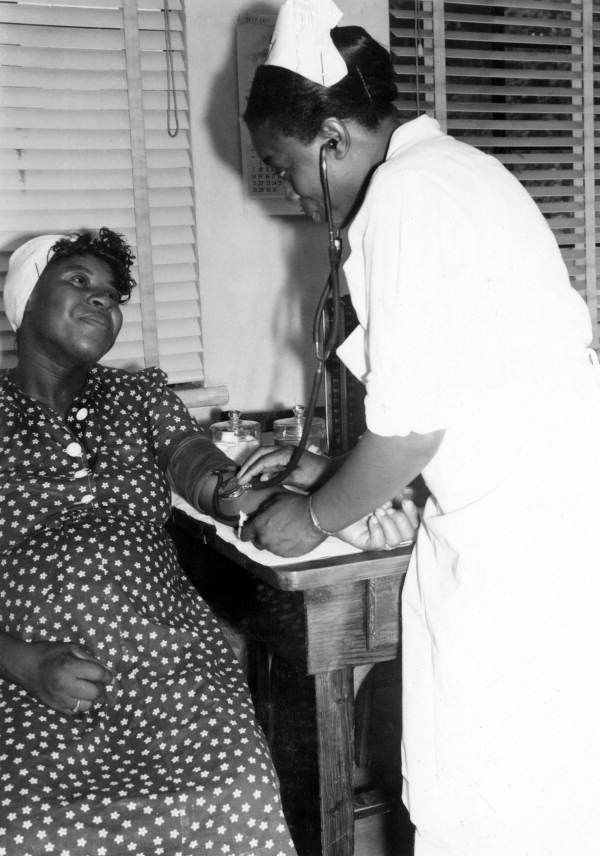
Expectant mother having her blood pressure taken by a registered nurse in Leon County, Florida. (State Archives of Florida / SBH0024)
RG 894 State Board of Health
S904
Midwife Program Files, 1924-1975
5.5 cubic feet
This series documents the Board's midwife
licensing program and contains correspondence, reports of legislation, essays on midwifery, midwife manuals and publications, photographs, administration records, licenses and artifacts. There is correspondence on Black midwifery, a speech concerning the licensing of Black midwives, the transcript of a story on midwifery which briefly recounts the practice of a Black midwife, and photographs of Black midwives and their clients.
S1481
Bureau of Narcotics Applications for Certificate of Registration for Healing Arts, 1928-1955
35 microfilm reels
This series contains applications by physicians, surgeons, osteopaths, chiropractors, naturopaths and midwives for certification and registration to practice the healing arts. Also included are applications for masseurs and chiropodists from 1944-1947 and 1951-1958 and physical therapist applications from 1952-1955. Information on the applications includes full name, business and residential addresses, sex, race, date and place of birth, length of Florida residency, former addresses, county of residence and date of application.
RG 897 State Welfare Board
S871
Historical Files, 1927-1950
0.25 cubic foot
Historical files of the State Welfare Board and its predecessors, the State Board of Social Welfare and the State Board of Public Welfare, include historical information on welfare assistance, social security, child welfare, the Adoption Act of 1943, the organization of the Board and the first biennial report of the State Board of Public Welfare. The files include reports, photographs and newspaper clippings as well as a 1935 "Report on Social Security in Florida" discussing race problems and noting that 36 percent of the state's population was Black. The report also includes photographs documenting inadequate housing for Black Floridians.
RG 1000 State Constitutional Records
S539
Constitution, 1885
1 item
This series contains the 1885 Constitution for the State of Florida as drafted by the Constitutional Convention. This new constitution made segregation of public schools mandatory, legitimized poll taxes as prerequisites for voting, and prohibited marriage between citizens of different races.
RG 1021 State Census Records
S5
Tenth Census of the State of Florida, 1935
101 cubic feet, 20 microfilm reels
This series contains the original schedule of the 10th Florida state census. The schedule includes the name, address (whether inside or outside city limits), age, sex, race, relation to family, place of birth, degree of education, whether homeowner or renter, and occupation. There is no index to these records.
S1364
Incomplete Fourth Census of the State of Florida [Alachua County only], 1875
1 cubic foot, 1 microfilm reel
This series contains only the Alachua County returns of the fourth Florida state census. The information recorded includes the name, age, sex and race of all persons listed. Some entries include additional information, such as occupation, value of real estate and personal property, number of acres of planted cotton or cane and the number of planted orange trees.
S1371
Eleventh Census of the State of Florida, 1945
64 cubic feet, 43 microfilm reels
This series contains the original schedule for the 11th Florida state census, which includes the name, address (whether inside or outside city limits), age, sex, race, relation to family, place of birth, degree of education, whether homeowner or renter, and occupation. Records for several precincts are not included.
S1373
First Census of the State of Florida, 1845
1 item
This series contains the census returns from the first Florida state census from Alachua, Benton, Columbia, Duval, Gadsden, Hamilton, Hillsborough, Jackson, Jefferson, Leon, Madison, Marion, Orange, St. Johns, Walton, Wakulla and Washington counties. The enumeration lists the county and name of the census taker, the number of white men over and under 21, the number of white women over and under 18, the number of enslaved Black men and women, and the number of free Black men and women. It does not list names.
S1374
Second Census of the State of Florida, 1855
0.25 cubic foot
This series contains Marion County returns for the second Florida state census, which are the only known existing state census records for 1855. The record includes the name of the head of the family; the number of white males over and under 21; the number of white females over and under 18; the number of children between 5 and 18; the number of children in schools; the number of enslaved Black men and women and their associated monetary value; the number of free Black men and women; the number of acres of and value of land; and the value of buildings, furniture and plantation livestock.
S1375
Third Census of the State of Florida, 1867
1 cubic foot, 1 microfilm reel
This series contains returns from the third Florida state census for Hernando, Madison, Orange and Santa Rosa counties. The series includes total tabulations for the state and miscellaneous record fragments, such as a page listing for the enumeration of Franklin County. There are separate listings for “colored” and white inhabitants, which are further denoted by sex and age.
S1647
Incomplete Fifth Census of the State of Florida [Leon County only], 1885
2 folders
This series contains only the Leon County returns for the fifth Florida state census. The records contain the name, age, sex and race of those persons enumerated. The enumeration is segregated by race and contains an alphabetical index that lists the names and ages of Black men over the age of 21.

 Listen: The Blues Program
Listen: The Blues Program